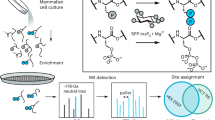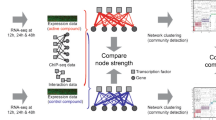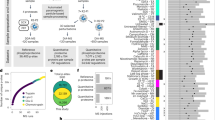Abstract
Bacterial phosphosignalling has been synonymous with two-component systems and their histidine kinases, but many bacteria, including Mycobacterium tuberculosis (Mtb), also code for Ser/Thr protein kinases (STPKs). STPKs are the main phosphosignalling enzymes in eukaryotes but the full extent of phosphorylation on protein Ser/Thr and Tyr (O-phosphorylation) in bacteria is untested. Here we explored the global signalling capacity of the STPKs in Mtb using a panel of STPK loss-of-function and overexpression strains combined with mass spectrometry-based phosphoproteomics. A deep phosphoproteome with >14,000 unique phosphosites shows that O-phosphorylation in Mtb is a vastly underexplored protein modification that affects >80% of the proteome and extensively interfaces with the transcriptional machinery. Mtb O-phosphorylation gives rise to an expansive, distributed and cooperative network of a complexity that has not previously been seen in bacteria and that is on par with eukaryotic phosphosignalling networks. A resource of >3,700 high-confidence direct substrate–STPK interactions and their transcriptional effects provides signalling context for >80% of Mtb proteins and allows the prediction and assembly of signalling pathways for mycobacterial physiology.
This is a preview of subscription content, access via your institution
Access options
Access Nature and 54 other Nature Portfolio journals
Get Nature+, our best-value online-access subscription
$29.99 / 30 days
cancel any time
Subscribe to this journal
Receive 12 digital issues and online access to articles
$119.00 per year
only $9.92 per issue
Buy this article
- Purchase on Springer Link
- Instant access to full article PDF
Prices may be subject to local taxes which are calculated during checkout






Similar content being viewed by others
Data availability
The mass spectrometry data reported in this paper are available in Supplementary Tables 1 and 2. Raw files are available under MassIVE accession no. MSV000088254 at https://massive.ucsd.edu/ProteoSAFe/dataset.jsp?task=e7a33adf4a424aef9eaad14ec5ddc5b4. The mass spectrometry data were searched against the Mtb database RefSeq H37Rv_uid57777_2014-08-14 with 20,198 entries. RNA-seq data are available in Supplementary Table 3. The RNA-seq data are deposited in the Gene Expression Omnibus under accession no. GSE195959. Sequencing reads were mapped to the Mtb (NCBI GenBank accession no. AL123456.3). The Mtb STPK mutant strains are available upon request. Source data are provided with this paper.
Code availability
To assess the relative abundance of transcripts, we implemented a custom analysis pipeline in R v.3.3.0. The code used to process the RNA-seq reads is available at https://github.com/robertdouglasmorrison/DuffyNGS and https://github.com/robertdouglasmorrison/DuffyTools.
References
Dworkin, J. Ser/Thr phosphorylation as a regulatory mechanism in bacteria. Curr. Opin. Microbiol. 24, 47–52 (2015).
Stock, A. M., Robinson, V. L. & Goudreau, P. N. Two-component signal transduction. Annu. Rev. Biochem. 69, 183–215 (2000).
Kannan, N., Taylor, S. S., Zhai, Y., Venter, J. C. & Manning, G. Structural and functional diversity of the microbial kinome. PLoS Biol. 5, e17 (2007).
Krupa, A. & Srinivasan, N. Diversity in domain architectures of Ser/Thr kinases and their homologues in prokaryotes. BMC Genomics 6, 129 (2005).
Leonard, C. J., Aravind, L. & Koonin, E. V. Novel families of putative protein kinases in bacteria and archaea: evolution of the ‘eukaryotic’ protein kinase superfamily. Genome Res. 8, 1038–1047 (1998).
Stancik, I. A. et al. Serine/threonine protein kinases from bacteria, archaea and eukarya share a common evolutionary origin deeply rooted in the tree of life. J. Mol. Biol. 430, 27–32 (2018).
Kennelly, P. J. Protein Ser/Thr/Tyr phosphorylation in the Archaea. J. Biol. Chem. 289, 9480–9487 (2014).
Av-Gay, Y. & Everett, M. The eukaryotic-like Ser/Thr protein kinases of Mycobacterium tuberculosis. Trends Microbiol. 8, 238–244 (2000).
Cole, S. T. et al. Deciphering the biology of Mycobacterium tuberculosis from the complete genome sequence. Nature 393, 537–544 (1998).
Carette, X. et al. Multisystem analysis of Mycobacterium tuberculosis reveals kinase-dependent remodeling of the pathogen–environment interface. mBio 9, e02333-17 (2018).
Zeng, J. et al. Protein kinases PknA and PknB independently and coordinately regulate essential Mycobacterium tuberculosis physiologies and antimicrobial susceptibility. PLoS Pathog. 16, e1008452 (2020).
Molle, V. & Kremer, L. Division and cell envelope regulation by Ser/Thr phosphorylation: Mycobacterium shows the way. Mol. Microbiol. 75, 1064–1077 (2010).
Kusebauch, U. et al. Mycobacterium tuberculosis supports protein tyrosine phosphorylation. Proc. Natl Acad. Sci. USA 111, 9265–9270 (2014).
Prisic, S. et al. Extensive phosphorylation with overlapping specificity by Mycobacterium tuberculosis serine/threonine protein kinases. Proc. Natl Acad. Sci. USA 107, 7521–7526 (2010).
Alber, T. Signaling mechanisms of the Mycobacterium tuberculosis receptor Ser/Thr protein kinases. Curr. Opin. Struct. Biol. 19, 650–657 (2009).
Sherman, D. R. & Grundner, C. Agents of change—concepts in Mycobacterium tuberculosis Ser/Thr/Tyr phosphosignalling. Mol. Microbiol. 94, 231–241 (2014).
Breitkreutz, A. et al. A global protein kinase and phosphatase interaction network in yeast. Science 328, 1043–1046 (2010).
Schneiker, S. et al. Complete genome sequence of the myxobacterium Sorangium cellulosum. Nat. Biotechnol. 25, 1281–1289 (2007).
Baer, C. E., Iavarone, A. T., Alber, T. & Sassetti, C. M. Biochemical and spatial coincidence in the provisional Ser/Thr protein kinase interaction network of Mycobacterium tuberculosis. J. Biol. Chem. 289, 20422–20433 (2014).
Roskoski, R. Jr. Properties of FDA-approved small molecule protein kinase inhibitors: a 2021 update. Pharmacol. Res. 165, 105463 (2021).
Prisic, S. & Husson, R. N. Mycobacterium tuberculosis serine/threonine protein kinases. Microbiol. Spectr. https://doi.org/10.1128/microbiolspec.MGM2-0006-2013 (2014).
van Kessel, J. C. & Hatfull, G. F. Recombineering in Mycobacterium tuberculosis. Nat. Methods 4, 147–152 (2007).
Rock, J. M. et al. Programmable transcriptional repression in mycobacteria using an orthogonal CRISPR interference platform. Nat. Microbiol. 2, 16274 (2017).
Soares, N. C., Spät, P., Krug, K. & Macek, B. Global dynamics of the Escherichia coli proteome and phosphoproteome during growth in minimal medium. J. Proteome Res. 12, 2611–2621 (2013).
Kelkar, D. S. et al. Proteogenomic analysis of Mycobacterium tuberculosis by high resolution mass spectrometry. Mol. Cell. Proteom. 10, M111 011627 (2011).
Arnvig, K. B. et al. Sequence-based analysis uncovers an abundance of non-coding RNA in the total transcriptome of Mycobacterium tuberculosis. PLoS Pathog. 7, e1002342 (2011).
Hornbeck, P. V. et al. PhosphoSitePlus, 2014: mutations, PTMs and recalibrations. Nucleic Acids Res. 43, D512–D520 (2015).
Olsen, J. V. et al. Quantitative phosphoproteomics reveals widespread full phosphorylation site occupancy during mitosis. Sci. Signal. 3, ra3 (2010).
Sharma, K. et al. Ultradeep human phosphoproteome reveals a distinct regulatory nature of Tyr and Ser/Thr-based signaling. Cell Rep. 8, 1583–1594 (2014).
Griffin, J. E. et al. High-resolution phenotypic profiling defines genes essential for mycobacterial growth and cholesterol catabolism. PLoS Pathog. 7, e1002251 (2011).
Kanshin, E., Giguere, S., Jing, C., Tyers, M. & Thibault, P. Machine learning of global phosphoproteomic profiles enables discrimination of direct versus indirect kinase substrates. Mol. Cell. Proteomics 16, 786–798 (2017).
Bodenmiller, B. et al. Phosphoproteomic analysis reveals interconnected system-wide responses to perturbations of kinases and phosphatases in yeast. Sci. Signal. 3, rs4 (2010).
Rustad, T. R. et al. Mapping and manipulating the Mycobacterium tuberculosis transcriptome using a transcription factor overexpression-derived regulatory network. Genome Biol. 15, 502 (2014).
Hunter, T. & Karin, M. The regulation of transcription by phosphorylation. Cell 70, 375–387 (1992).
Maciag, A. et al. Global analysis of the Mycobacterium tuberculosis Zur (FurB) regulon. J. Bacteriol. 189, 730–740 (2007).
Baros, S. S., Blackburn, J. M. & Soares, N. C. Phosphoproteomic approaches to discover novel substrates of mycobacterial Ser/Thr protein kinases. Mol. Cell. Proteomics 19, 233–244 (2020).
van Kessel, J. C. & Hatfull, G. F. Mycobacterial recombineering. Methods Mol. Biol. 435, 203–215 (2008).
Wang, Y. et al. Reversed-phase chromatography with multiple fraction concatenation strategy for proteome profiling of human MCF10A cells. Proteomics 11, 2019–2026 (2011).
Mertins, P. et al. Reproducible workflow for multiplexed deep-scale proteome and phosphoproteome analysis of tumor tissues by liquid chromatography–mass spectrometry. Nat. Protoc. 13, 1632–1661 (2018).
Zhang, H. et al. Integrated proteogenomic characterization of human high-grade serous ovarian cancer. Cell 166, 755–765 (2016).
Elias, J. E. & Gygi, S. P. Target-decoy search strategy for increased confidence in large-scale protein identifications by mass spectrometry. Nat. Methods 4, 207–214 (2007).
Qian, W.-J. et al. Probability-based evaluation of peptide and protein identifications from tandem mass spectrometry and SEQUEST analysis: the human proteome. J. Proteome Res. 4, 53–62 (2005).
Kim, S., Gupta, N. & Pevzner, P. A. Spectral probabilities and generating functions of tandem mass spectra: a strike against decoy databases. J. Proteome Res. 7, 3354–3363 (2008).
Cox, J. & Mann, M. MaxQuant enables high peptide identification rates, individualized p.p.b.-range mass accuracies and proteome-wide protein quantification. Nat. Biotechnol. 26, 1367–1372 (2008).
Clair, G. et al. Spatially-resolved proteomics: rapid quantitative analysis of laser capture microdissected alveolar tissue samples. Sci. Rep. 6, 39223 (2016).
Shi, T. et al. Targeted quantification of low ng/ml level proteins in human serum without immunoaffinity depletion. J. Proteome Res. 12, 3353–3361 (2013).
Nielson, C. M. et al. Free 25-hydroxyvitamin D: impact of vitamin D binding protein assays on racial-genotypic associations. J. Clin. Endocrinol. Metab. 101, 2226–2234 (2016).
Shi, T. et al. Antibody-free, targeted mass-spectrometric approach for quantification of proteins at low picogram per milliliter levels in human plasma/serum. Proc. Natl Acad. Sci. USA 109, 15395–15400 (2012).
MacLean, B. et al. Skyline: an open source document editor for creating and analyzing targeted proteomics experiments. Bioinformatics 26, 966–968 (2010).
He, J. et al. Antibody-independent targeted quantification of TMPRSS2-ERG fusion protein products in prostate cancer. Mol. Oncol. 8, 1169–1180 (2014).
Acknowledgements
This work was supported by National Institutes of Health (NIH) grant nos. R01AI117023, R01AI158159, R21AI137571 and R03AI131223 and by a grant from the American Lung Association to C.G. A.F. was supported by the Interdisciplinary Program in Bacterial Pathogenesis no. 5T32AI053396. Portions of this research were supported by NIH National Institute of General Medical Sciences GM103493. Some of the work was performed in the Environmental Molecular Sciences Laboratory, a US Department of Energy Office of Biological and Environmental Research national scientific user facility located at Pacific Northwest National Laboratory. The Pacific Northwest National Laboratory is operated by Battelle for the US Department of Energy under contract no. DE-AC05-76RLO 1830.
Author information
Authors and Affiliations
Contributions
A.F. designed the work, was involved in sample generation, data acquisition, analysis and interpretation, and wrote the manuscript. V.B., M.G. and L.D. were involved in data acquisition. C.B., D.R.S. and S.M. were involved in data interpretation and discussion. J.M.J. was involved in data acquisition, analysis, interpretation and discussion. C.G. designed the work, was involved in data interpretation, organized the ideas, wrote the manuscript and was involved in the discussion.
Corresponding author
Ethics declarations
Competing interests
The authors declare no competing interests.
Peer review
Peer review information
Nature Microbiology thanks Yossef Av-Gay, Simone Lemeer and the other, anonymous, reviewer(s) for their contribution to the peer review of this work.
Additional information
Publisher’s note Springer Nature remains neutral with regard to jurisdictional claims in published maps and institutional affiliations.
Extended data
Extended Data Fig. 1 Characterization of STPK LOF and OE strains.
(a) Quantitation of mean STPK protein levels in LOF and OE Mtb mutant strains by selected reaction monitoring (n = 3 biologically independent replicates). PknB LOF is a knockdown strain, all other LOF strains are knockouts. Error bars show standard error of the mean. (b) Growth analysis of strains show only small growth effects of STPK perturbation and viability of strains in stationary phase (shown by regrowth after dilution). Error bars show standard error of the mean (n = 2 biologically independent replicates).
Extended Data Fig. 2
Overview of the MS experimental workflow.
Extended Data Fig. 3 Correlation of phosphosites and STPK abundance and kinase-independent effects on phosphoproteome.
(a) The abundance of STPKs in the OE mutants does not overall correlate with the number of phosphosites detected in these strains. Statistically significant correlation was evaluated by calculating a Pearson correlation coefficient and comparing against a Student’s t-distribution. (b) PknK kinase-dead OE causes only few changes in the phosphoproteome. Green dots indicate PknK peptides and show OE of PknK. Significance was determined by one-way ANOVA.
Extended Data Fig. 4 Contribution of STPKs to Mtb protein Tyr phosphorylation.
Number of Tyr phosphosites changed by STPK perturbation compared to WT.
Extended Data Fig. 5 Phosphosite-level overview of STPK substrates and overlap in substrate phosphorylation.
The purple squares represent the STPKs. The size of the square is proportional to the number of that STPK’s substrates, which is also given in parentheses. The round nodes show the number of sites phosphorylated by one or multiple STPKs. The thickness of the edge corresponds to the number of sites phosphorylated by the respective STPK.
Extended Data Fig. 6 Transcriptional effects of STPK perturbation.
Volcano plots show the DEGs in STPK mutant strains, direction of change, magnitude, and P value associated with the change. Horizontal and vertical red lines show significance cutoffs (>4-fold, P < 0.01) used for further analysis of DEGs. The STPKs that were altered in the respective strain were removed from the data as they showed the largest changes and distorted the plots. Plots are shown with different scales to avoid compression of data points. Significance was determined by calculating the geometric mean of five DE tools.
Extended Data Fig. 7 Relationship between STPK induction, phosphosites, and DEGs.
(a) More phosphorylation sites in the OE mutant strains led to more DEGs. PknJ affects the expression of a large number of genes through few phosphosites. Red line shows linear regression if outliers PknE and PknF are excluded. (b) STPK abundance is not correlated with the number of DEGs in the OE strains. Statistically significant correlation was evaluated by calculating a Pearson correlation coefficient and comparing against a Student’s t-distribution.
Extended Data Fig. 8 Transcriptional effects of a PknL and PknK kinase-dead mutant.
(a) The PknL kinase-dead mutant reduces the DEGs compared to WT OE from 260 to 1. PknL WT and kinase-dead transcripts are highlighted in green, showing induction in both cases. (b) The PknK kinase-dead mutant reduces DEGs compared to WT OE from 181 to 13, suggesting a small transcriptional effect of the PknK malT domain in the OE. PknK WT and kinase-dead transcripts are highlighted in green, showing induction in both cases. Horizontal and vertical red lines show significance cutoffs (>4-fold, P < 0.01) used for further analysis of DEGs. Significance was determined by calculating the geometric mean of five DE tools.
Supplementary information
Supplementary Table 1
Total phosphosites detected in the label-free and TMT datasets.
Supplementary Table 2
Total differential phosphorylation between STPK mutants and WT.
Supplementary Table 3
Total differential gene expression between STPK mutants and WT.
Source data
Source Data Fig. 1
Unprocessed in vitro phosphorylation assay gel and EMSA gel from Fig. 5.
Rights and permissions
Springer Nature or its licensor (e.g. a society or other partner) holds exclusive rights to this article under a publishing agreement with the author(s) or other rightsholder(s); author self-archiving of the accepted manuscript version of this article is solely governed by the terms of such publishing agreement and applicable law.
About this article
Cite this article
Frando, A., Boradia, V., Gritsenko, M. et al. The Mycobacterium tuberculosis protein O-phosphorylation landscape. Nat Microbiol 8, 548–561 (2023). https://doi.org/10.1038/s41564-022-01313-7
Received:
Accepted:
Published:
Issue Date:
DOI: https://doi.org/10.1038/s41564-022-01313-7



